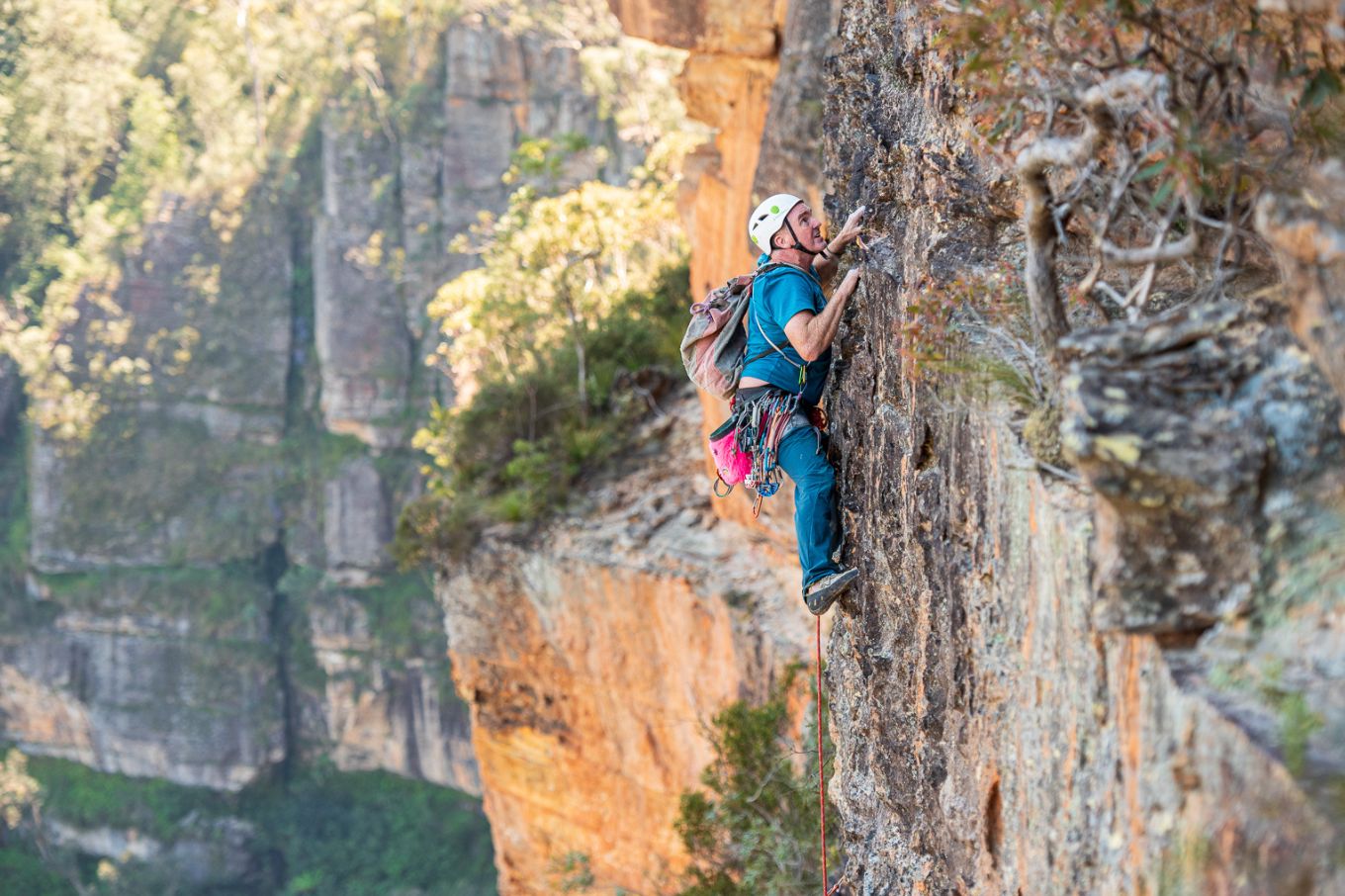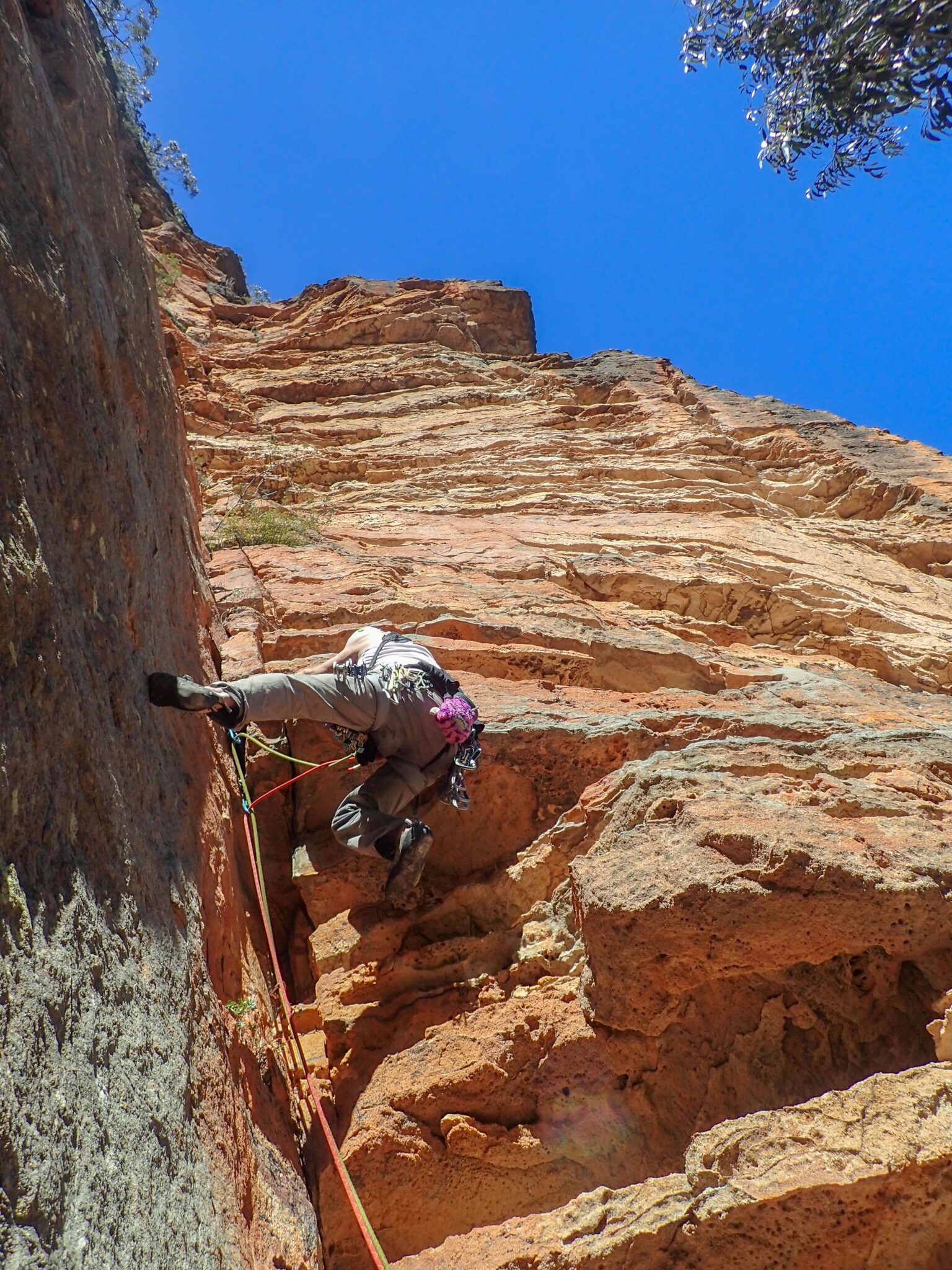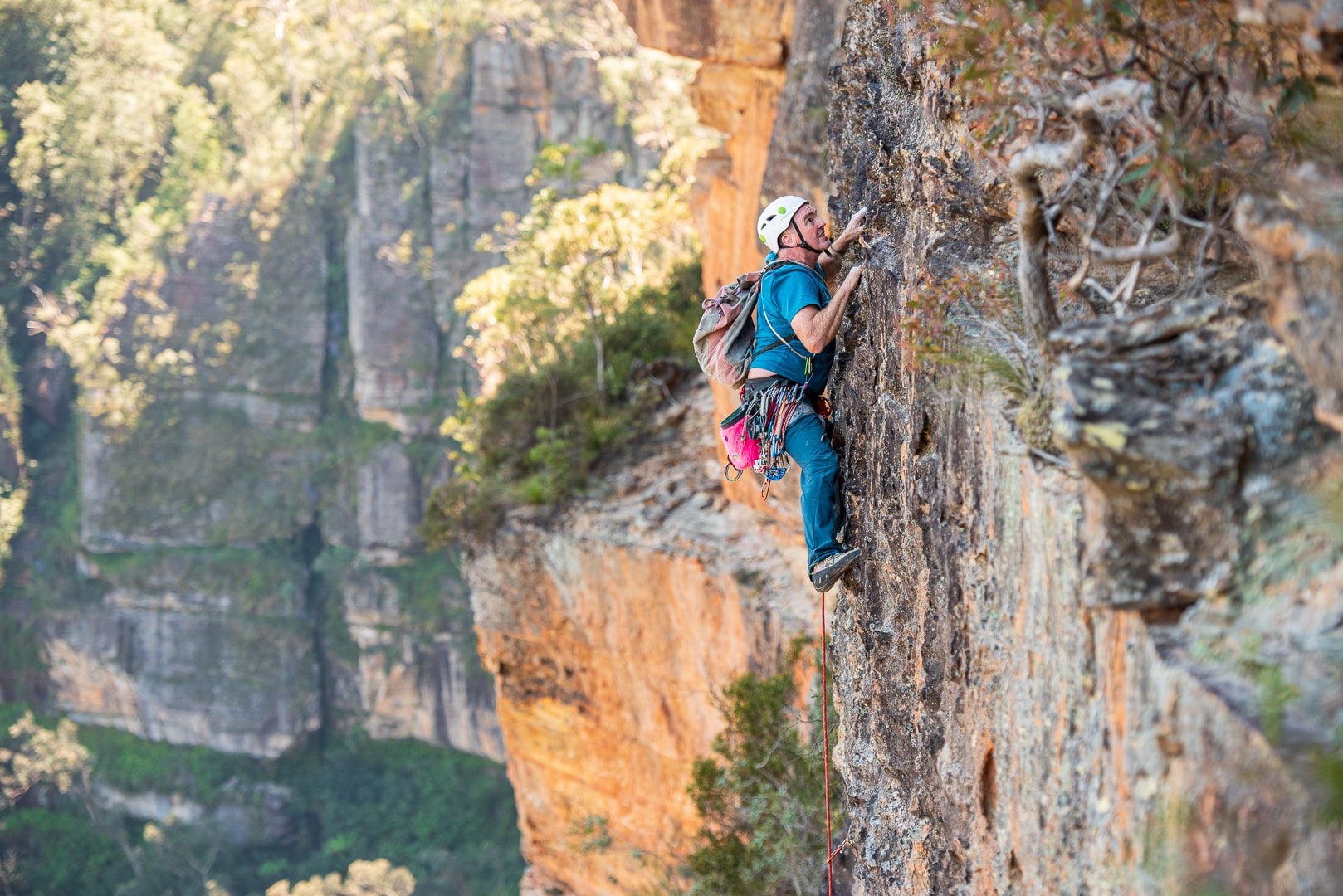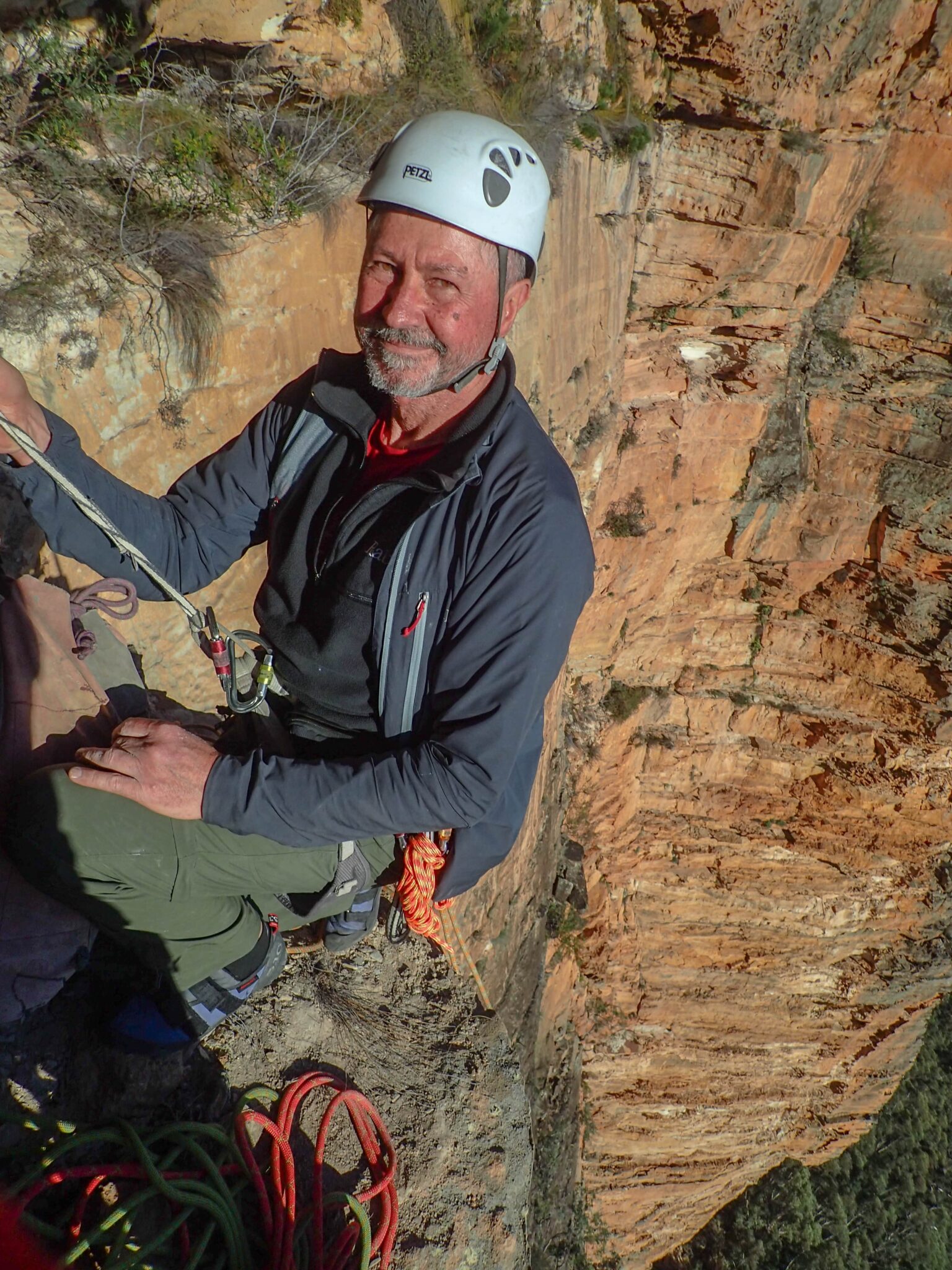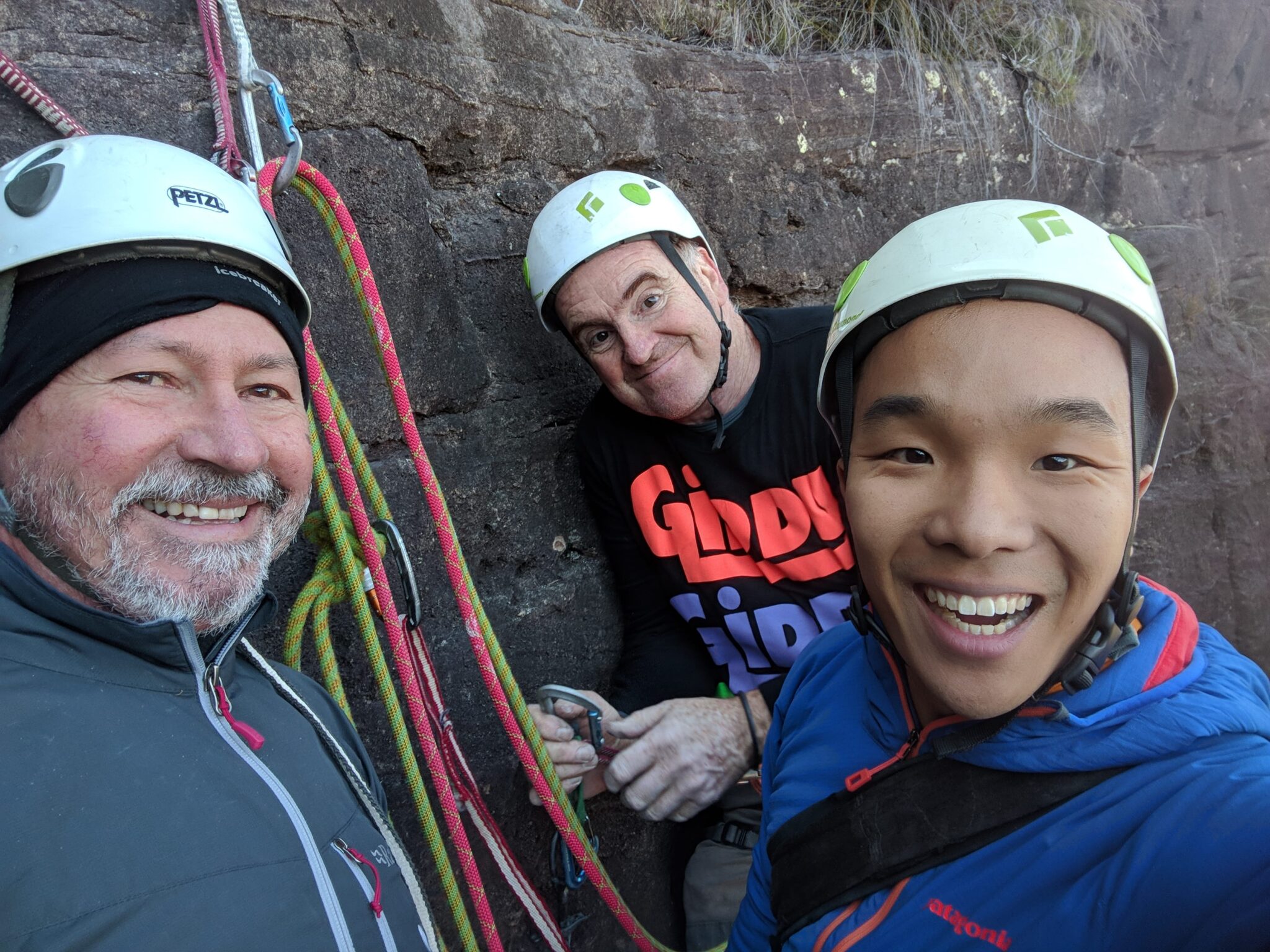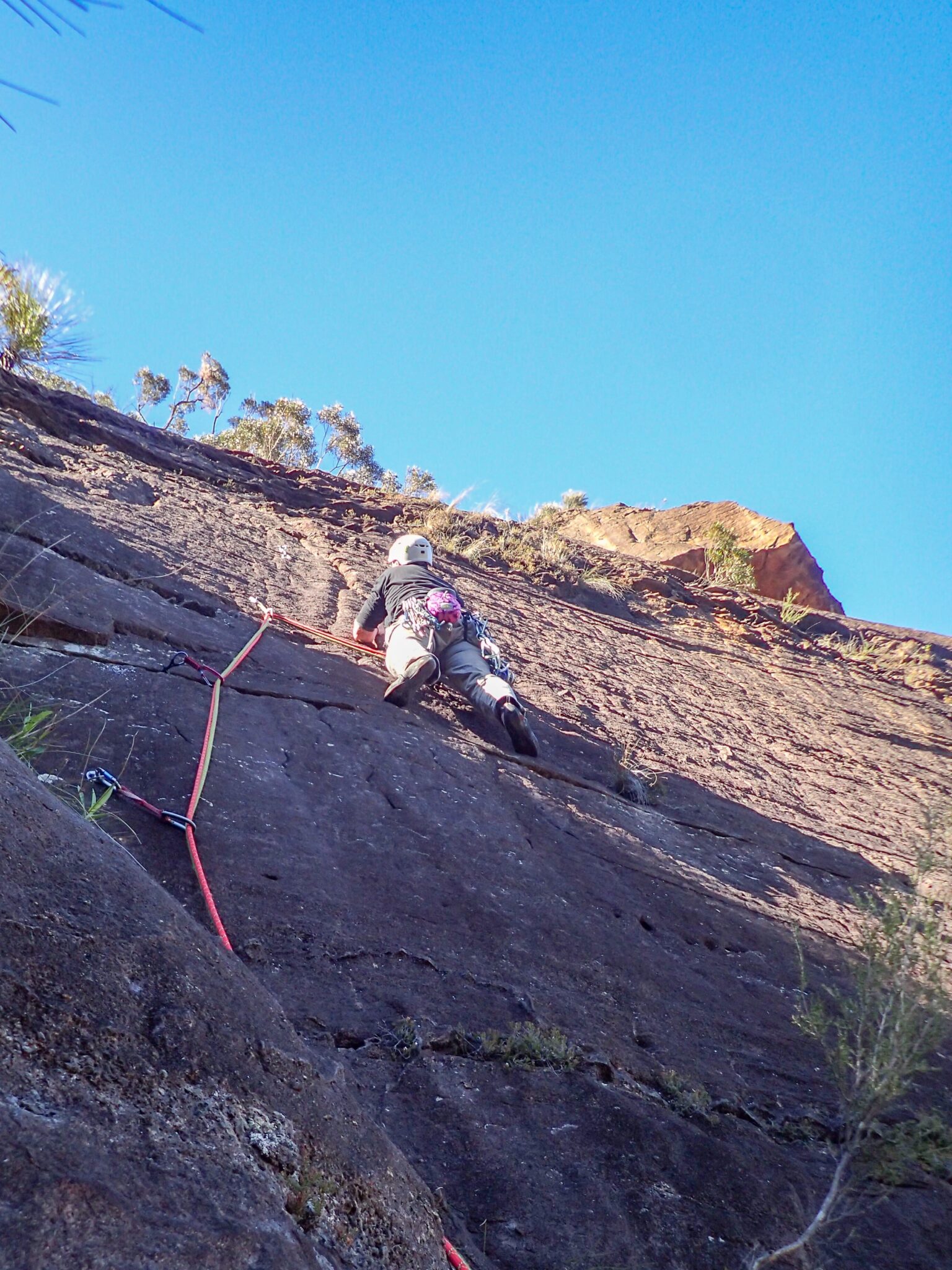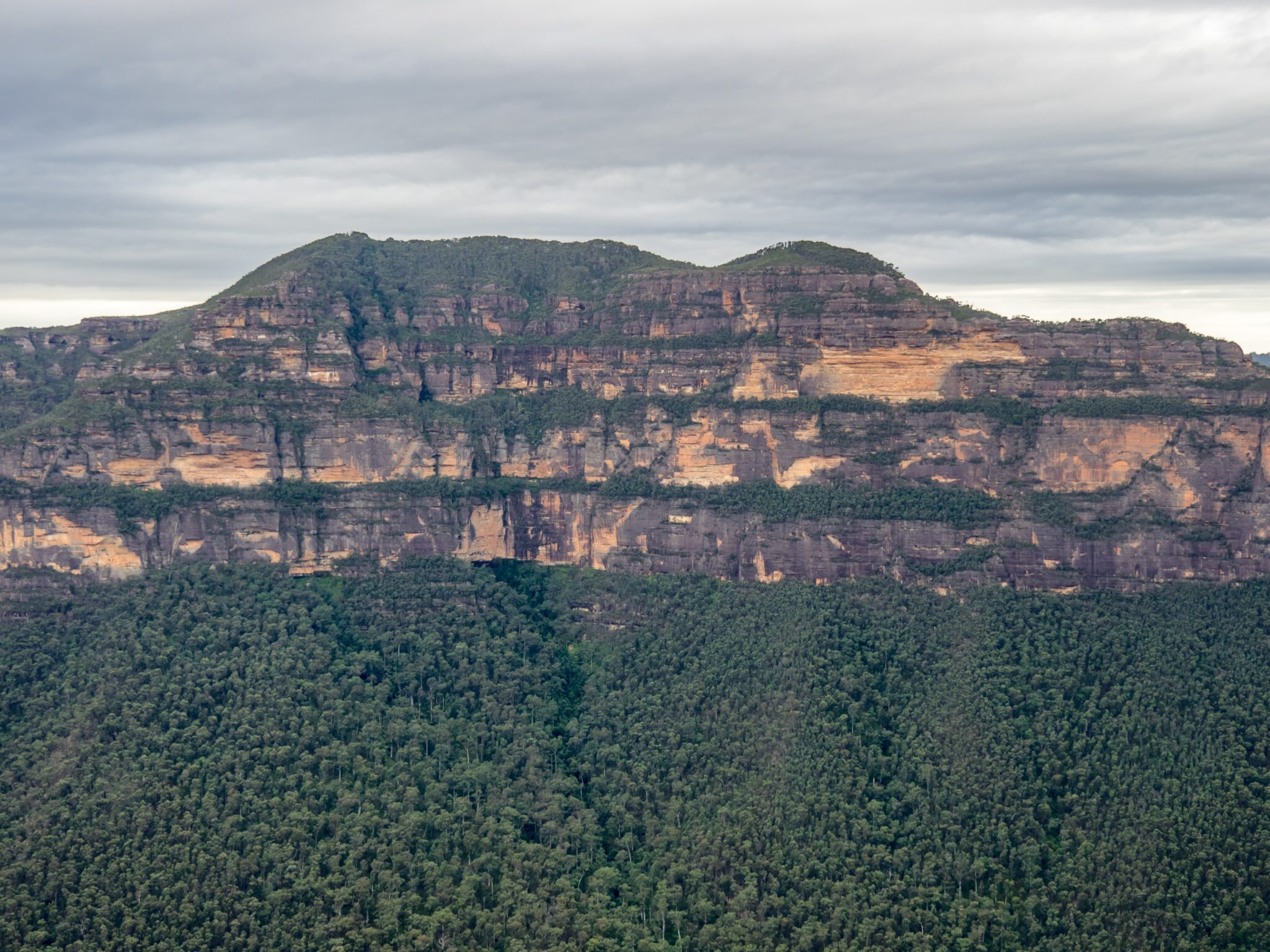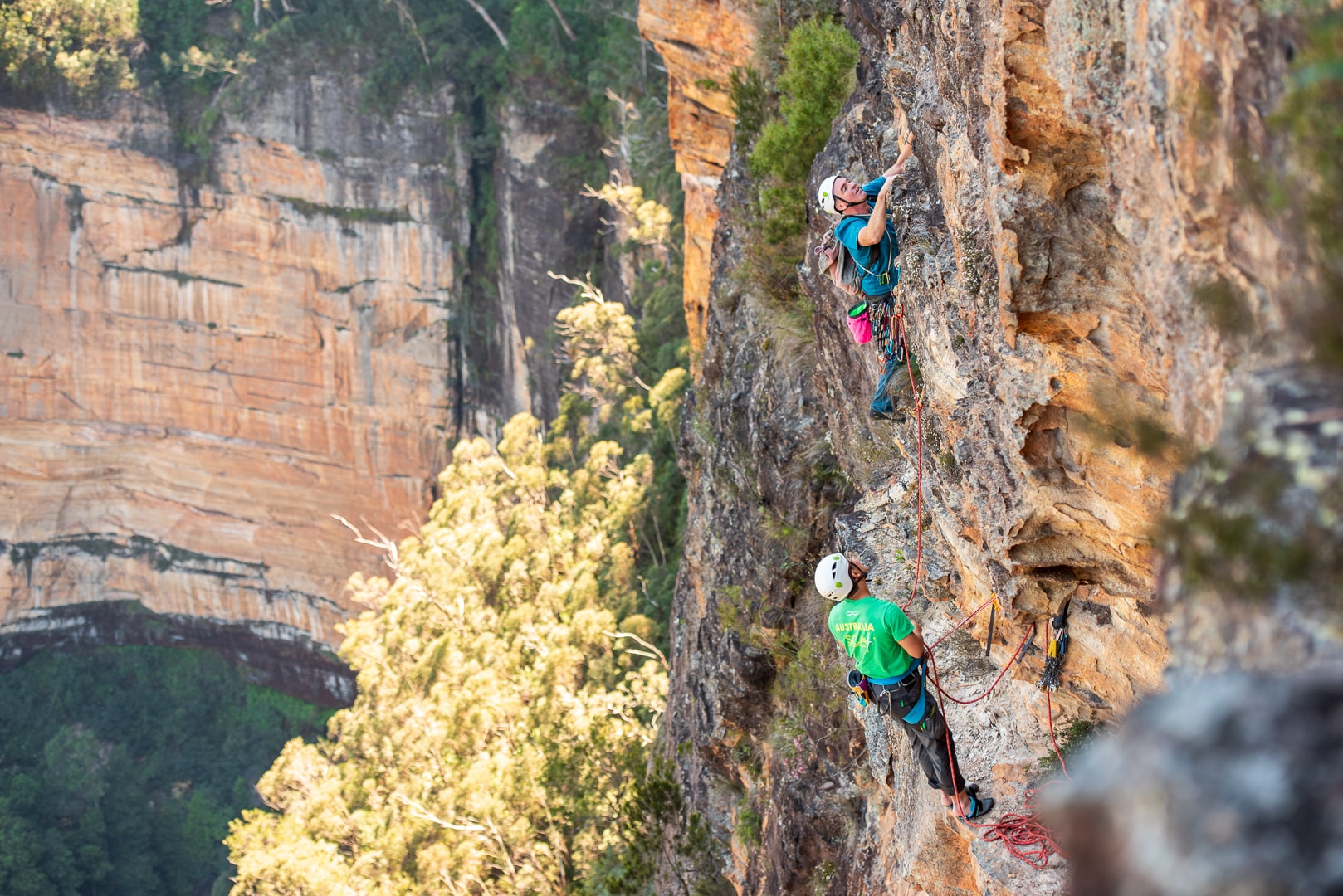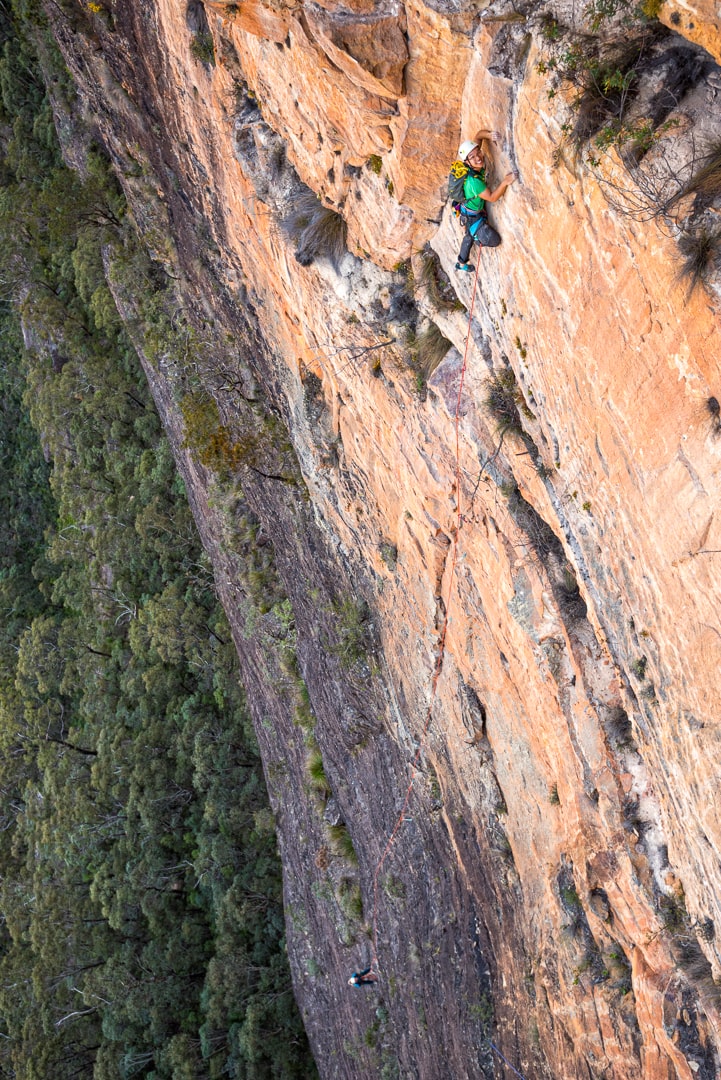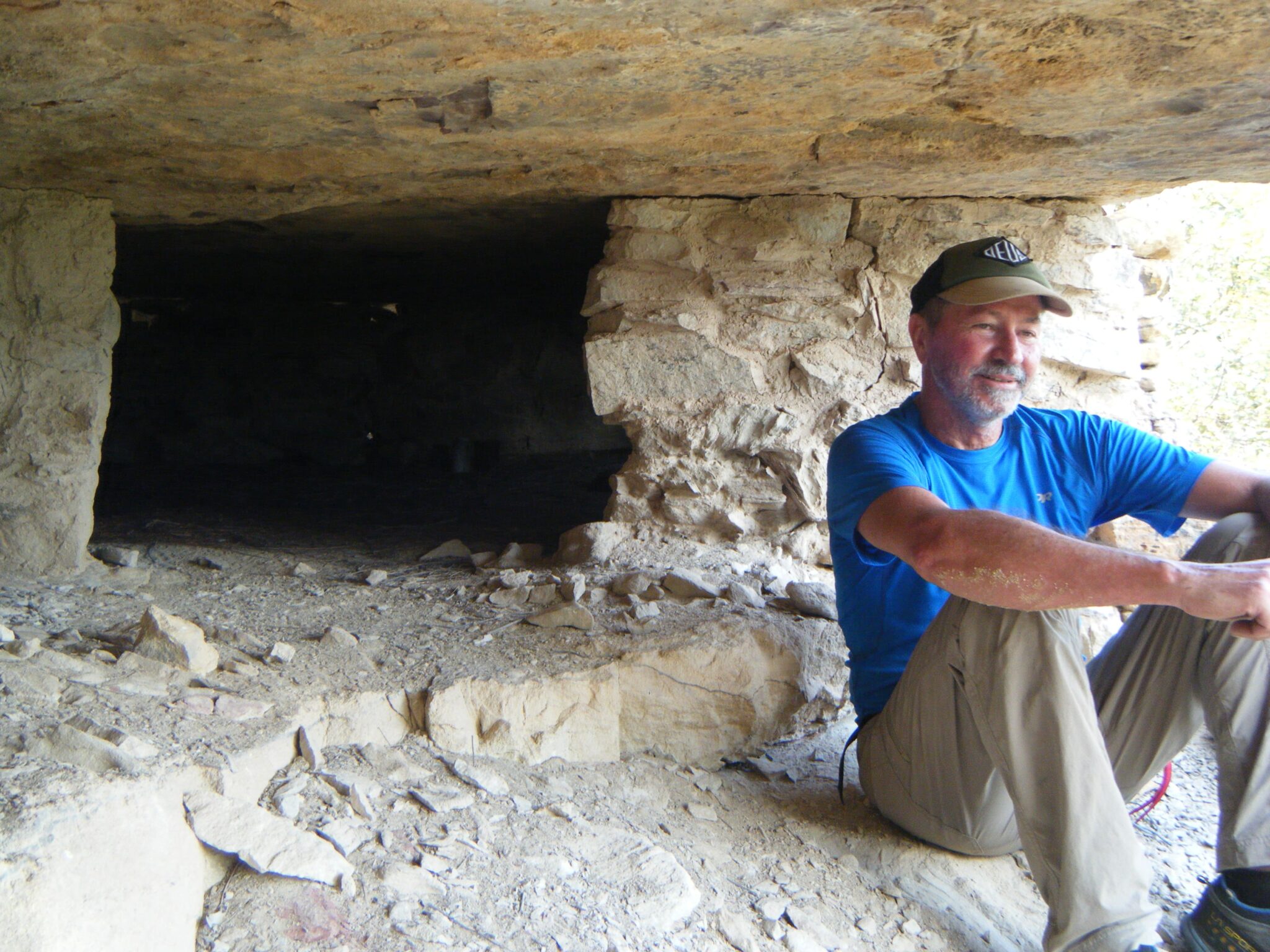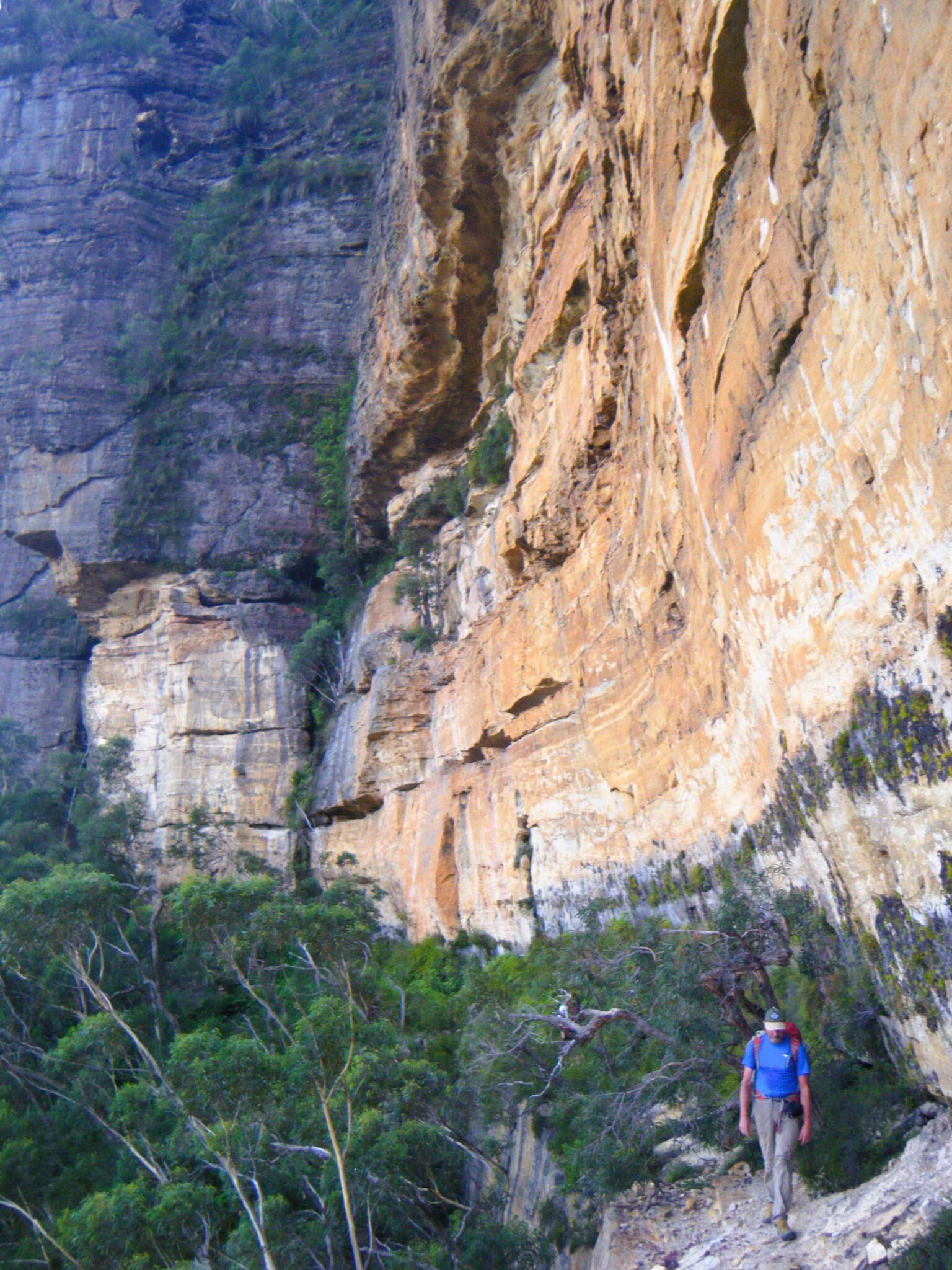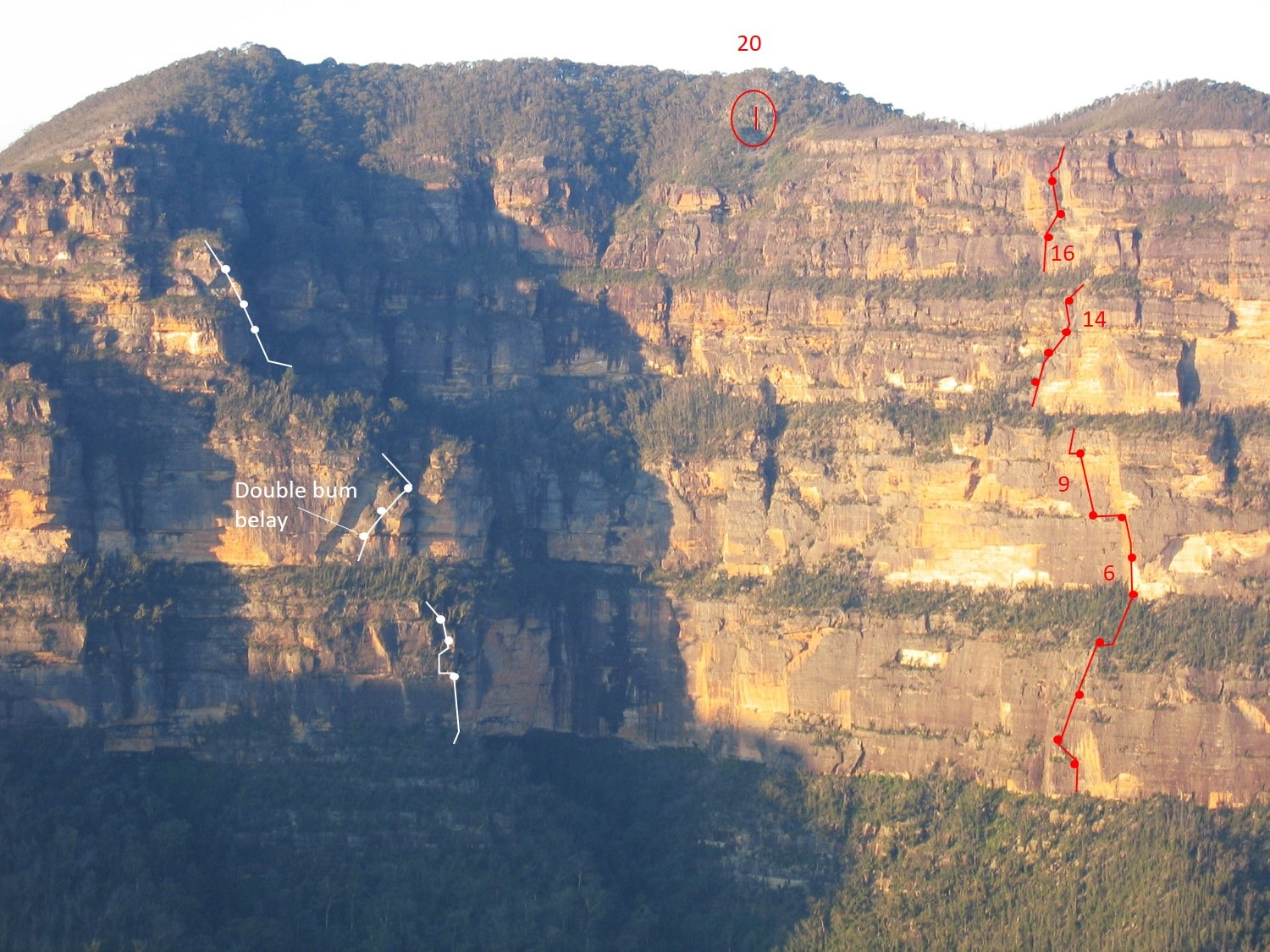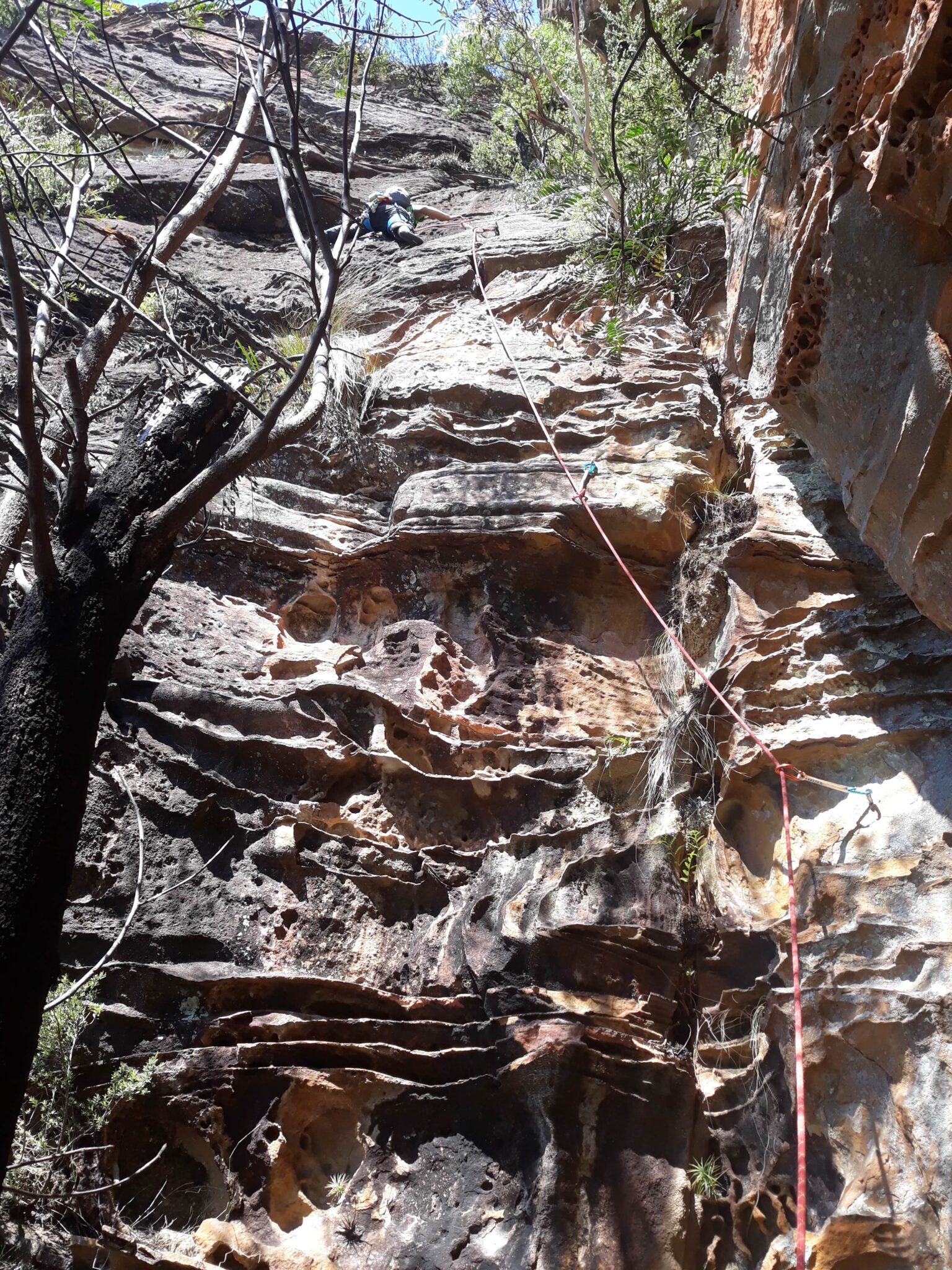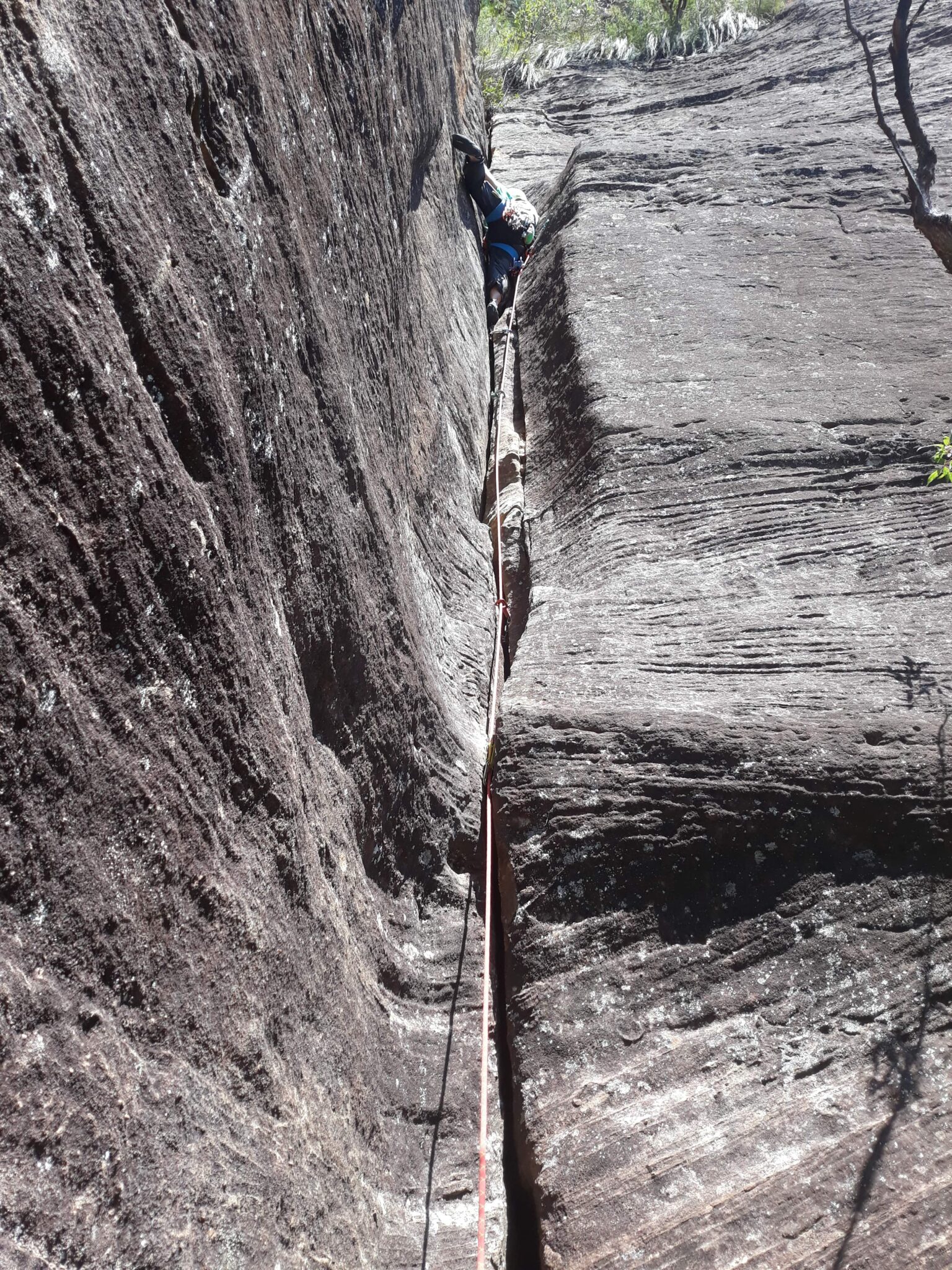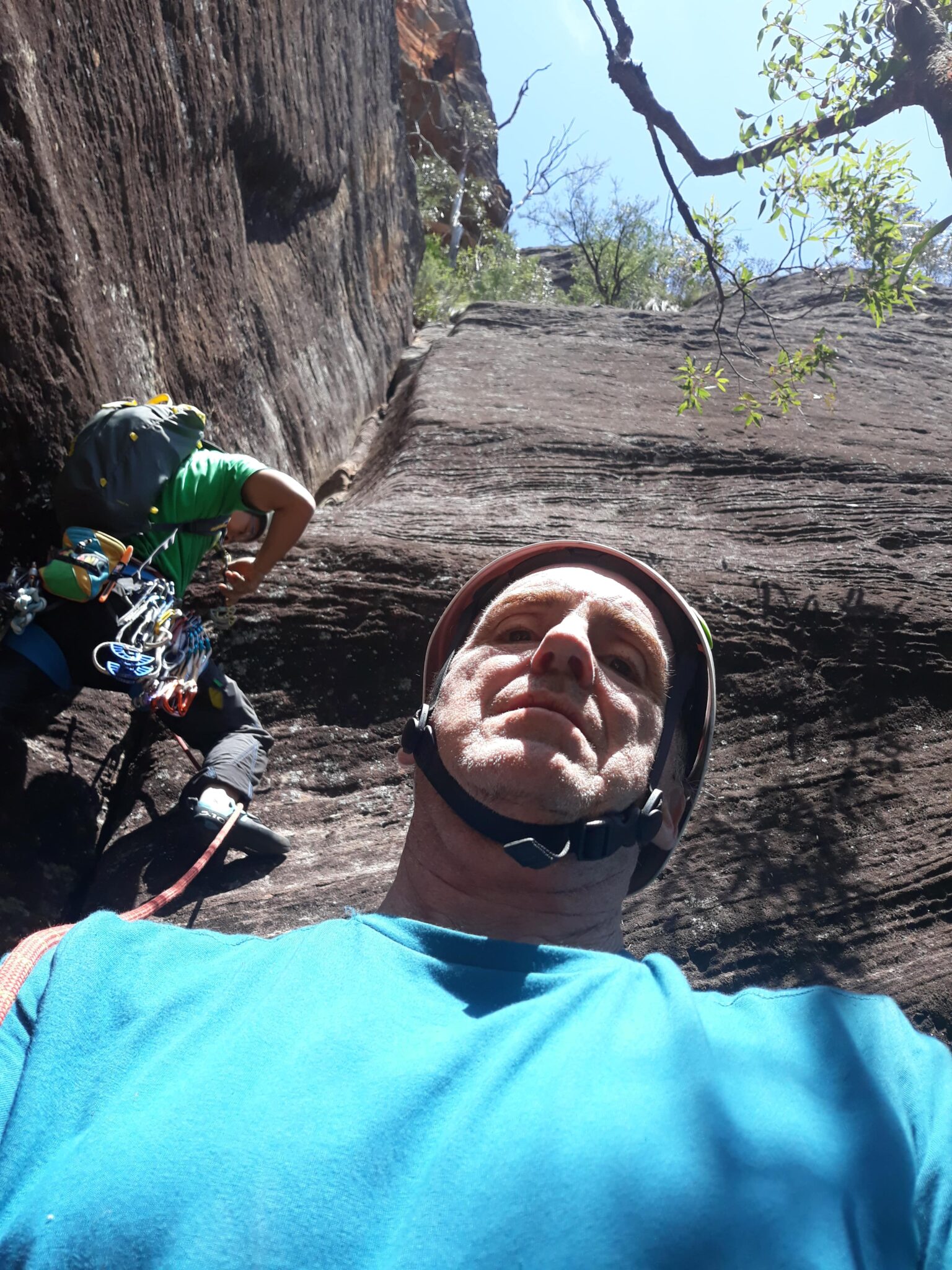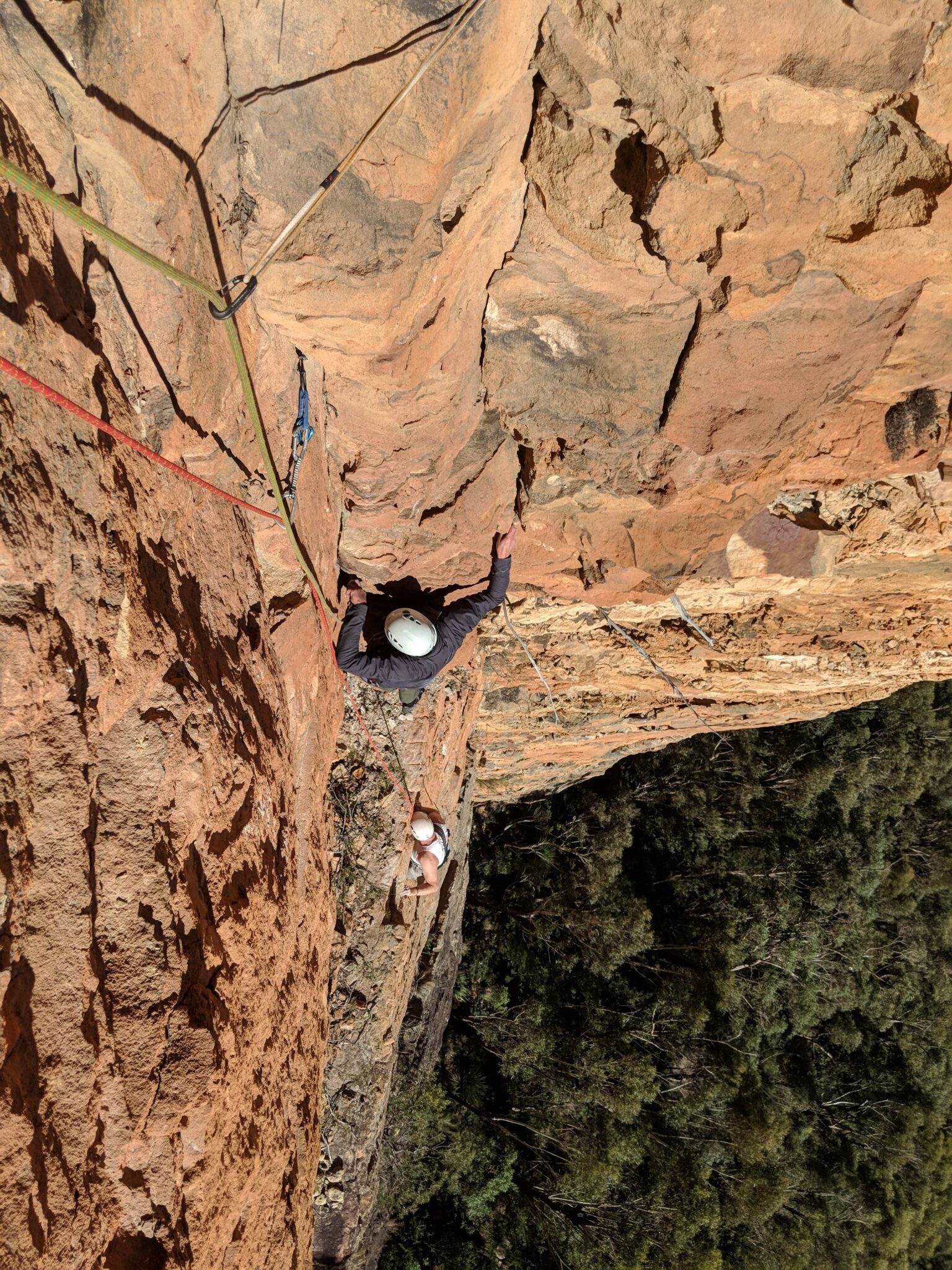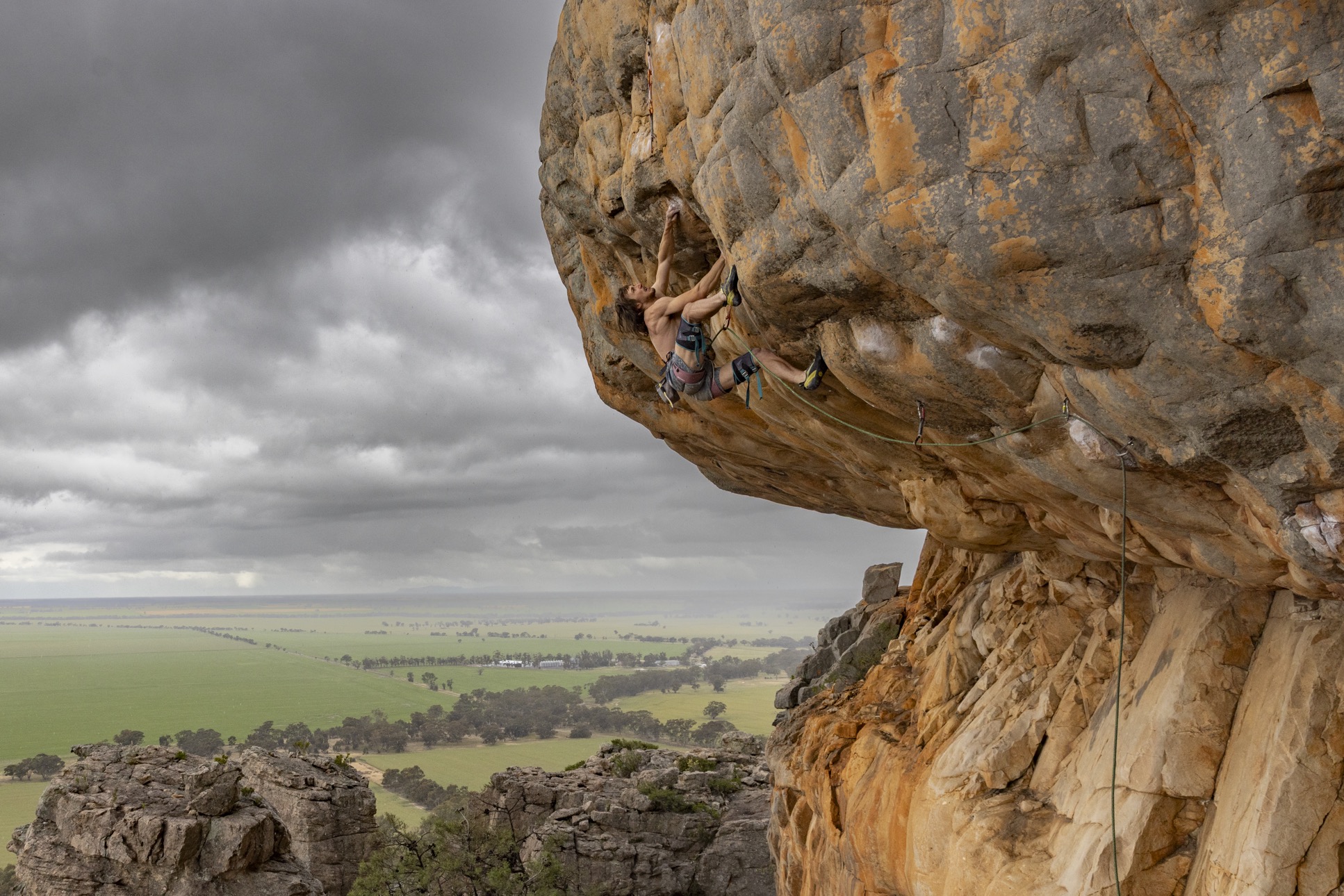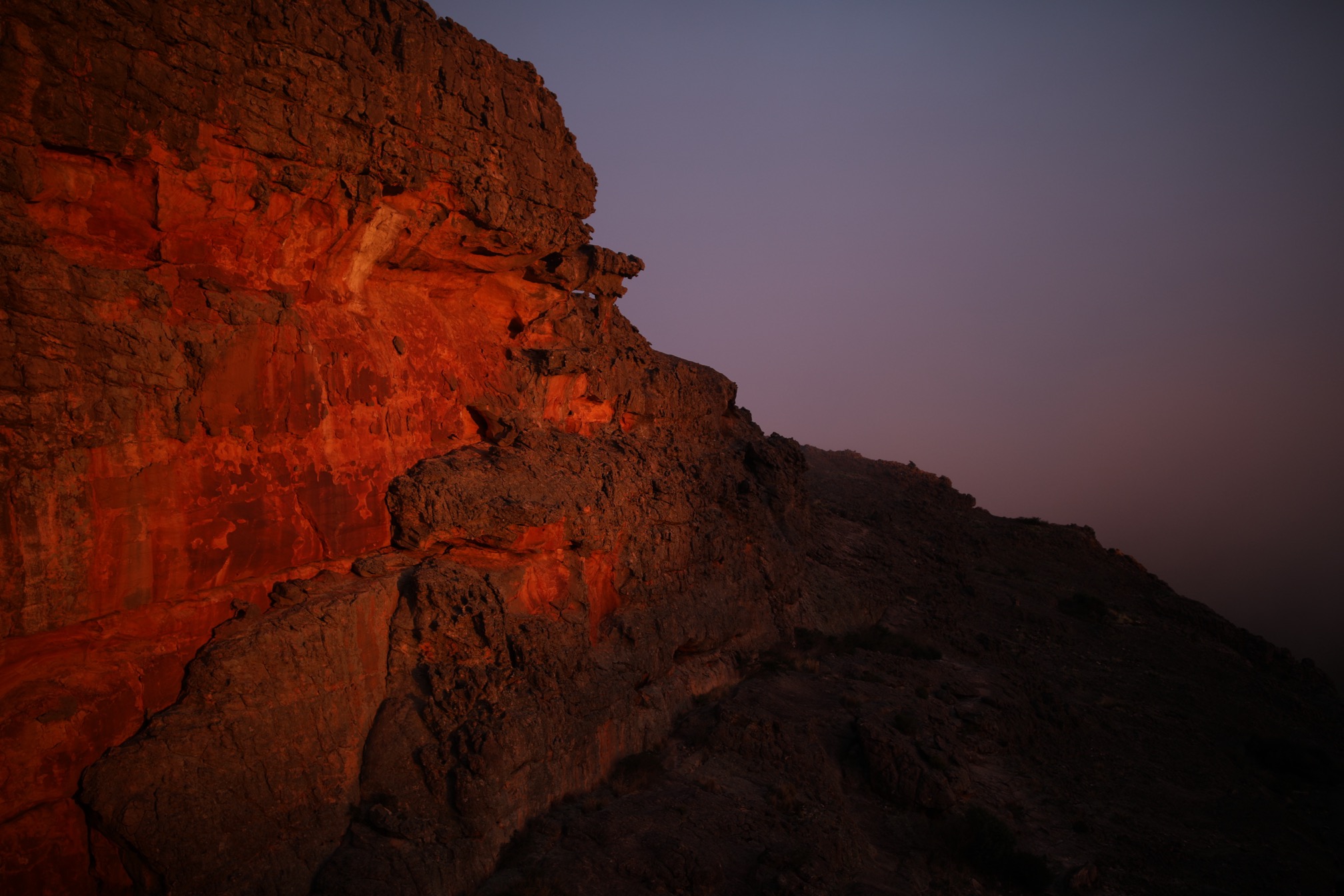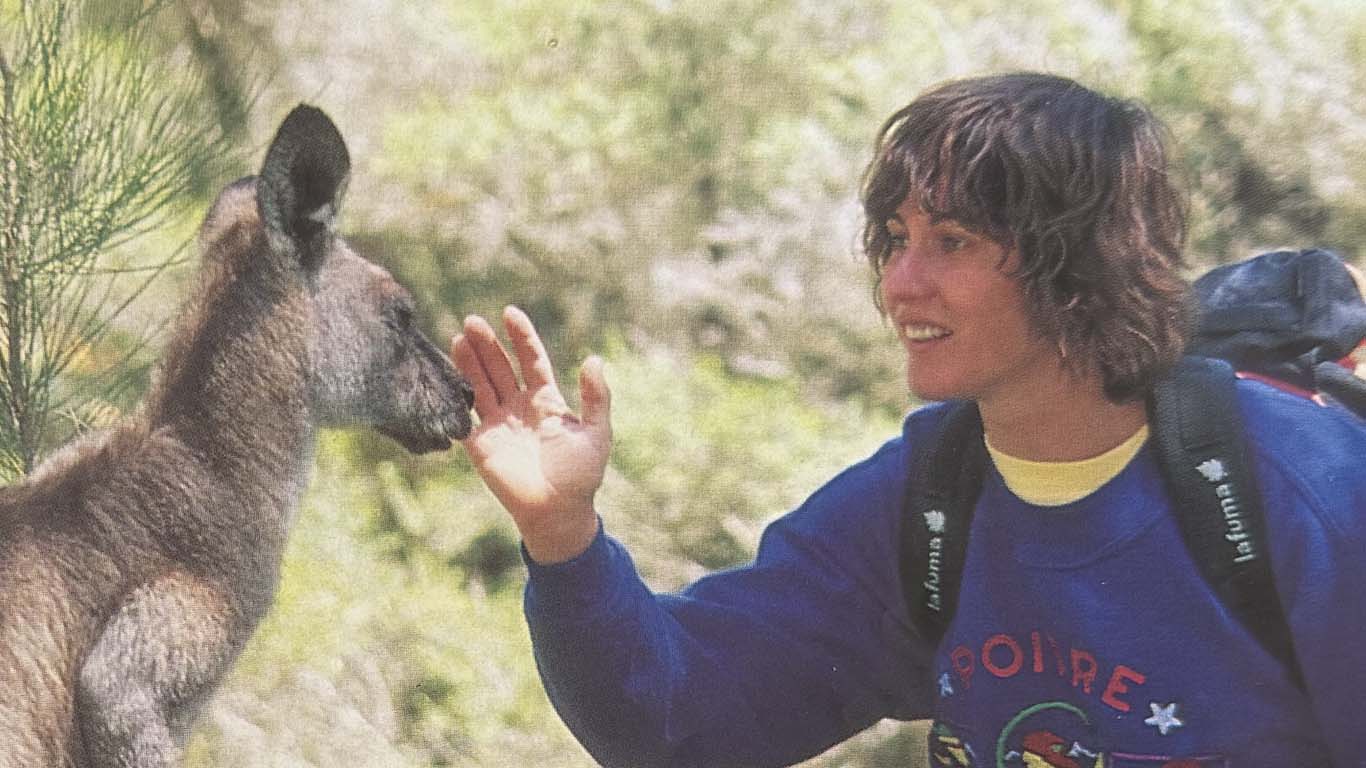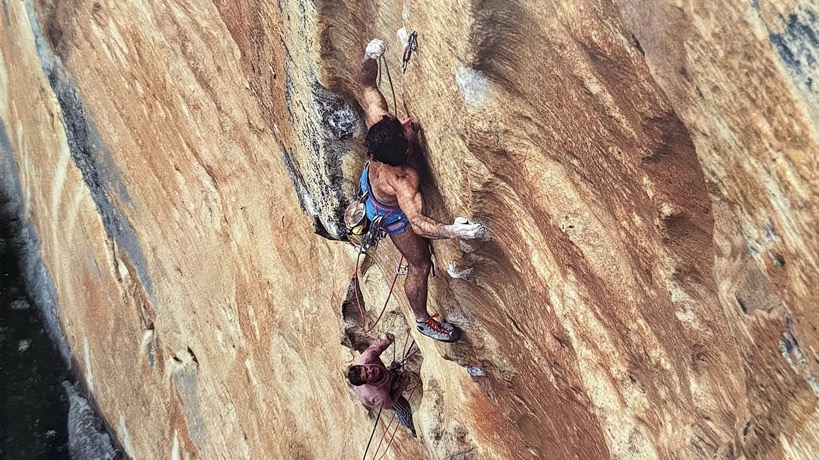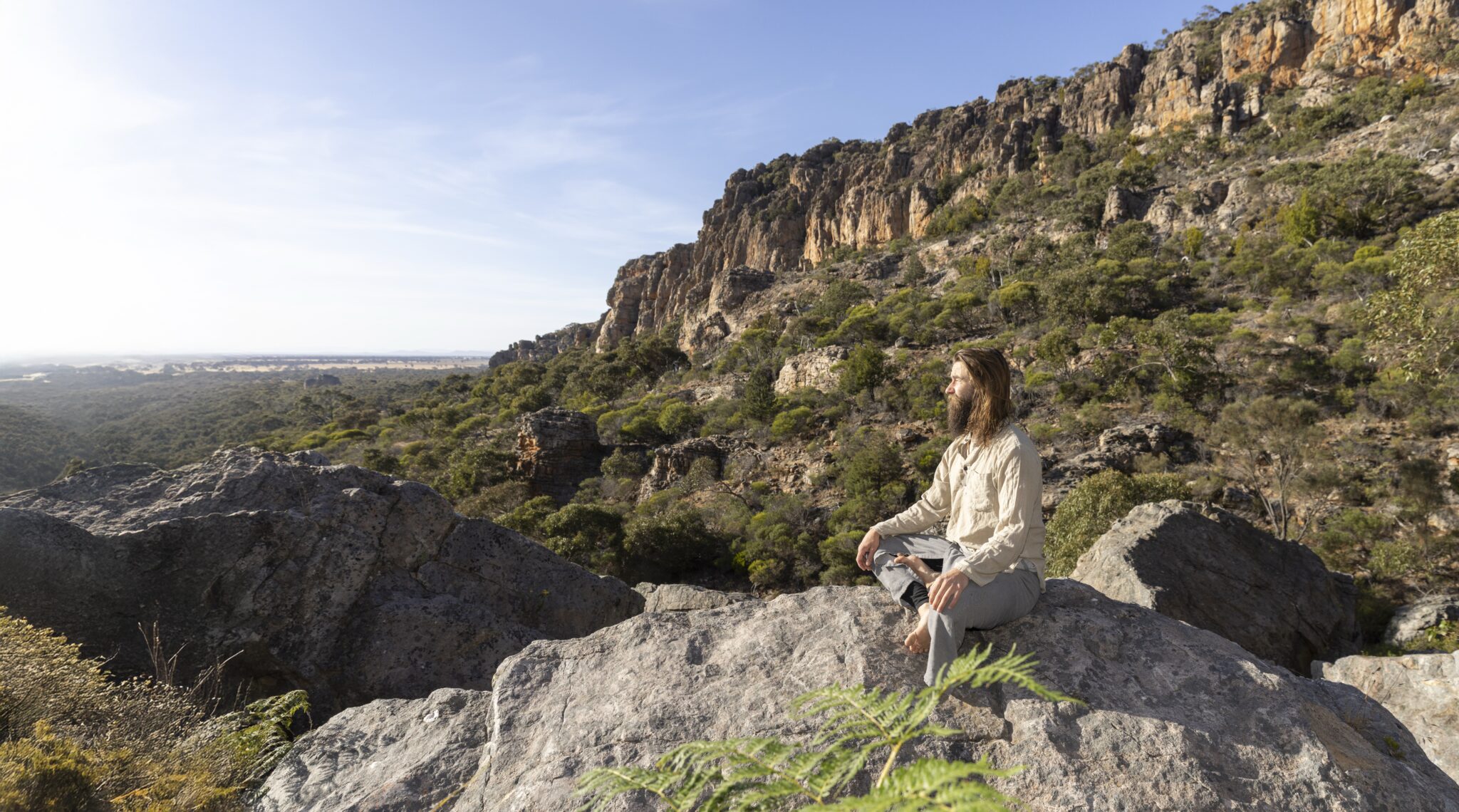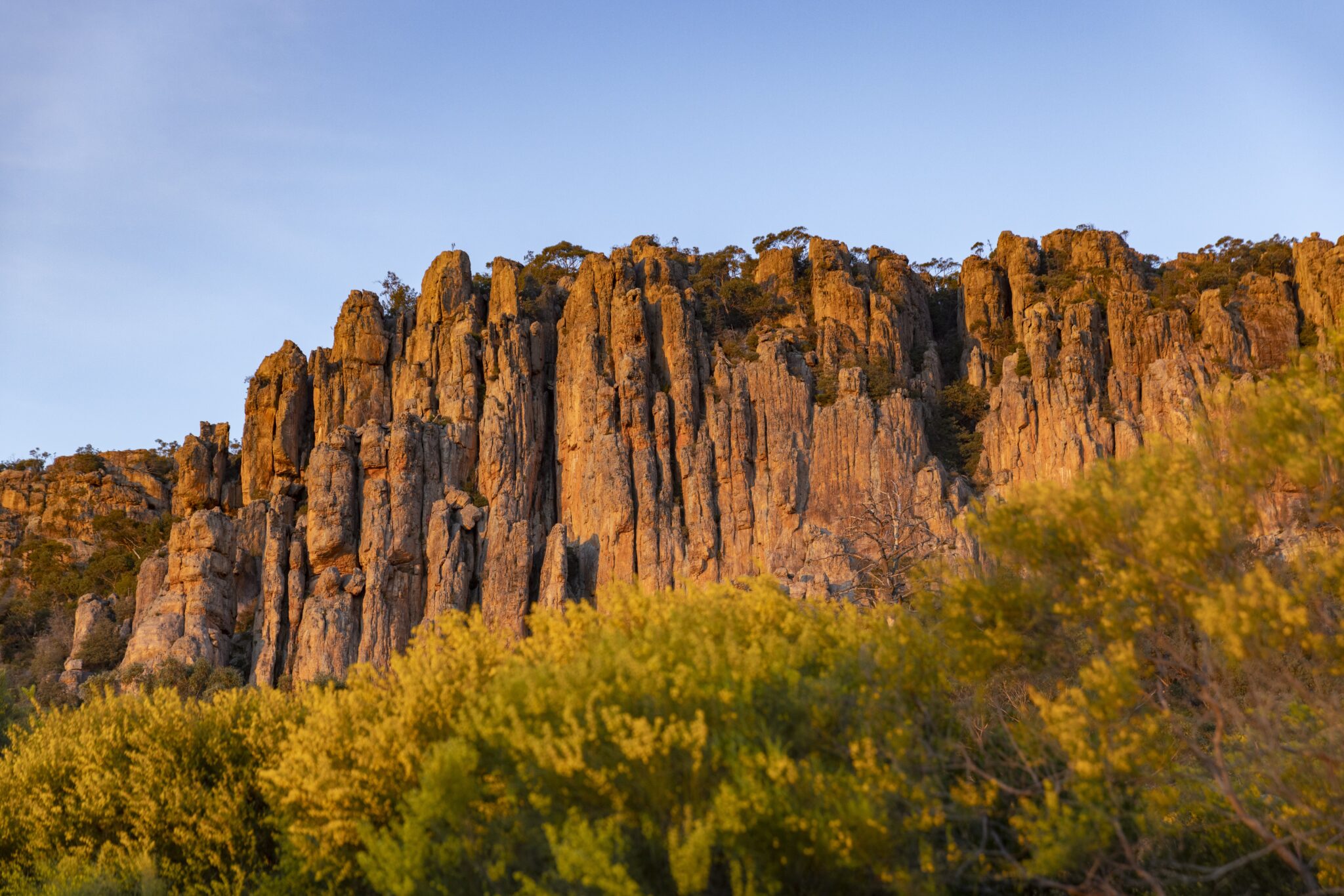Riding the Camel A Blue Mountains Climbing Adventure
Images by Mike Law and Simon Carter
Above Feature Photo by Simon Carter
(This article originally appeared in Vertical Life Magazine, Edition 49)
If you’re obsessed with climbing the longest line you can find—and with summer’s longer daylight this is the time to do it—Mikl has an idea for you. He takes us on a journey up The Camel, a 500 metre route he pioneered a few years back, as he considered what makes something an adventure.
“Adventure is just bad planning” – Roald Amundsen
Mt Banks is the biggest wall in the Blue Mountains at 400 metres high (plus ledges) and over two kilometres long, but it is really a layercake of four separate cliffs separated by scrubby ledges. The chances of anything good going through all four layers is small; most routes follow some decent climbing for a bit and then scumble up gullies for the next four hours.
I had long wondered if there was a way of stringing together reasonable climbing all the way. Every time I got out into the Grose I’d sneak another peek at the big pile of choss and snap a few more pictures from different angles, in different light. The centre was the most consistent and had the best climbing. If you look enough times, you’ll fantasise a line of features and possibilities.
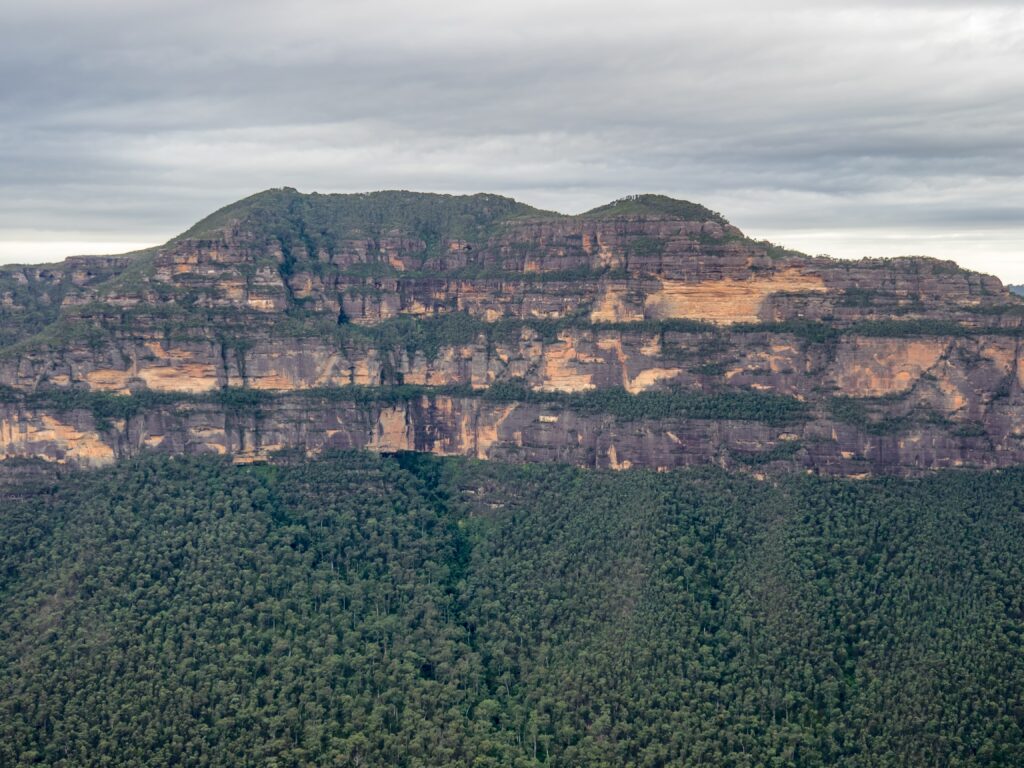
Ground up, on-sight climbing was how many of the great routes were done. It suits some rock (good rock, with holds and cracks, under vertical) better than others (steep, blankish, or chossy). Another way of doing new routes is with lots of knowledge—photographs and binoculars to find the best climbing. Sometimes abseiling the route to find holds and other hidden features helps.
The ground-up approach optimises the adventure. Inspection optimises the climbing. Both methods are good, but offer very different experiences. Two very different approaches were taken in Mt Banks on the original route—cleverly named “Original Route”—a grade 14 climbed in 1953 by Russ Kippax, Dave Roots, Enn Trupold and Owen Llewellyn and The Camel (20) which I climbed with Jeffrey Crass and Eugene Mak in 2018.
Original Route was an adventure with primitive gear and a lot of walking. It required multiple attempts, with a two to three hour approach from Perry’s Lookdown. And the same walk out for each failed attempt. Gear was limited to a few slings and pitons. As they only had hemp ropes and waist belays the leader never fell. And if they did fall, they didn’t survive to talk about it. And all this occurred on loose dirty rock. where scrub and trees are a bonus as they were often the only runners.
Each attempt was a very long day, though you could pre-order a taxi to wait for you at Perry’s Lookdown for 16 shillings, which would wait if the driver saw your lights coming up the hill. But, as Bryden Allen wrote in The Rockclimbs of NSW (1963), “One should be well acquainted with the departure time of the last train.”
With no gear for belays or runners, the chance of certain death for the whole party stopped attempts at a bulge above the fourth belay. Finally, the discovery of the double bum belay (or double arsehole belay, as Russ Kippax called it) made the steep pitch 5 possible.
The first ascent was made in time for Queen Elizabeth’s coronation in 1953 (just like Everest!). There were two bivouacs on big ledges; hauling the gear would have just added to the epic.
By comparison, the route we climbed in 2018 wasn’t an adventure, we had many photos from different angles that we’d pored over, and we inspected a lot of the climbing beforehand. All with the goal of finding an okay route (fair rock, climbing, and protection) up the wall without grinding to a halt in choss and running for the nearest gully.
For a first look at the wall I went out with Jeff and, helped by a lot of photos from the other side of the valley, found the little chimney that gives access down to the first ledge. We walked along this, surrounded by walls of rock and greenery till we got to Original Route (about an hour all up). I kept forgetting how huge the place was—what look like tiny chips of insignificance are actually 100 metre supercrags.
I decided to ”run up” Original route (pitch four, from the first ledge) but it was yukky (with a pack on) and unprotected with flaky rock. A big issue with these old routes is the imminence of certain death, or at least a long and painful crawl out with broken bits. We explored further, stumbling across the bizarre bivvy hut that was built in the 50s as a base for further explorations on the “biggest wall in Australia”. It is built in a 1.5 metre high slot and is super protected from weather by a huge roof above. But it has no water, and is a stiff half hour bush bash from Original Route.
Further right we got to the 100 metre high “Big Choss Corner” that runs between the first and second ledges. It was big, it was chossy. But it looked like okay climbing. We retreated back along the ledges with an idea of how big this place is. We wanted a trad route with a few bolts where needed (“Cosmic County Trad”) with trees or bolted belays (for retreat, and to limit the rack size needed).
After retirement, a surprise 60th birthday party, and alcohol poisoning, the temperature dropped and so climbing was ON! Eugene Mac joined our weird little choss cosplay group, we rode around the back of Mt Banks and rapped down the second then first cliffs. I stepped on a very large, very loose block near the top of the first tier and it rumbled down, exploded, and marked EVERY hold on the first 120 metres of black slab.
The slabs were good climbing on rippled black rock, a bit like the Grey Slab at Shipley Upper, for those familiar with the Blue Mountains. We were leading on twin singles (very heavy, very safe when surrounded by loose rock) and then simul-seconding (on new routes I never want to second on a skinny rope). The next few pitches were black slabs to a huge ledge system, we scrambled up to the base of the Big Choss Corner.
The left wall of the choss corner is a hard fused slip-plane with little sloping holds and a general slickness about it. The right wall is glorious juggy choss choss choss. The climbing was easy but it was hard to satisfy the “three pieces between me and an ambulance” dictum. I belayed at 30 metres (having used up all my gear); the corner above was a sandy mess for a while so Eugene went onto the left wall then back into the corner to belay.
Then (the worst pitch on the route) we walked/traversed/crawled left to a cave belay and then started up the long pitch nine above. A full rope length pitch is always fun, and the pitch gets steeper and easier as you go, but the weight from two single ropes (I’m a scared old guy) makes it a special type of workout. It finishes in a thin corner which is fortunately six grades easier than it looks, then a little traverse to a cool perch above the sucking void.
Eugene led the demolition pitch (P10) up the erosion groove above; every hold we grabbed exploded. We arrived at the second ledge having climbed about half the route in six hours. There were ten pitches, mostly grade 16-18. The top half of the route remained, but Blue Mountains winter puts a chill on any plans, particularly if the wind rises above a gentle breeze.
Just a few days after this I got a diagnosis of cancer. I assumed I’d die in surgery, so focused on fixing the house and writing wills. It all went well, but I had to wait to heal up. A few months later I came back with Jeff and (with a bit of sand and scrabbling of feet) we climbed the top half of the route.
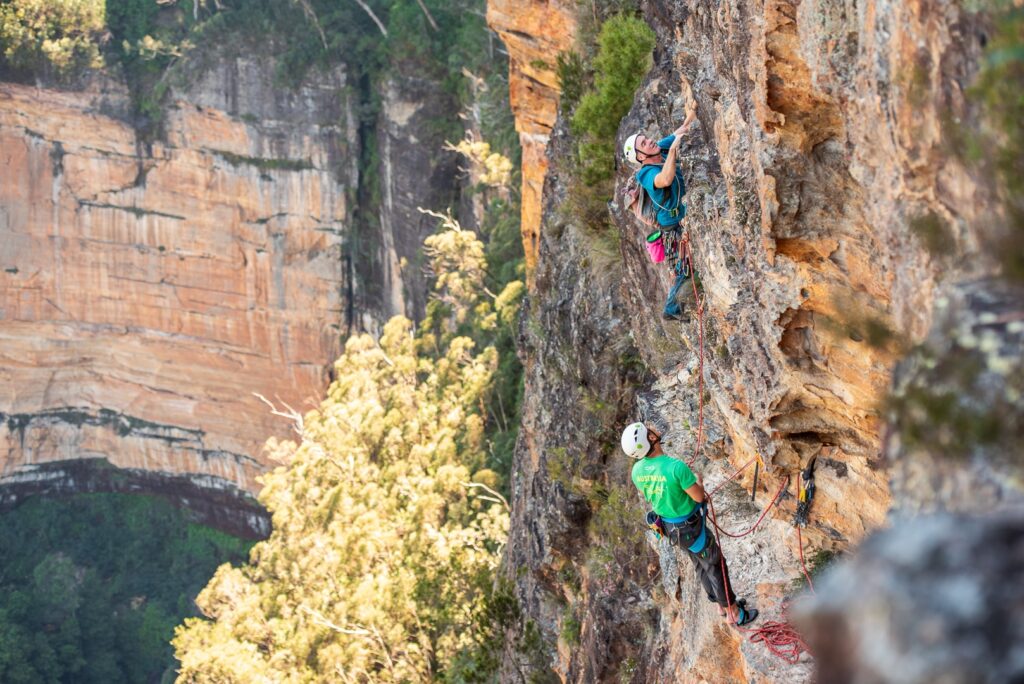
We waited for work and weather to align and soon Eugene and I headed out to climb the entire route. We dropped a bike at the Mt Banks car park and went down Pierces Pass at 6am, which was probably too late (with two cars you can go down Perrys Lookdown and save an hour of walking). I always forget how far it is down the river to Little Bluegum Forest. We crossed the river when we could see the Big Choss Corner, and thrashed through thick scrub uphill for two minutes before traversing to the ridgeline which was clear, and started climbing before 9am.
The first 100 metres is fast slab climbing on perfect black rock to scrubby ledge number one. Then we started up the Big Choss Corner, which seemed a lot nicer this time. Eugene got pitch nine (AKA the 11 o’clock pitch as it heads in that direction AND you need to be on it before 11am). It’s quite special; there aren’t many 50 metre trad pitches in the mountains. I wobbled up the demolition pitch and we had a break on ledge number two at noon then, walked left to the dirty pitch 11 which was still shedding sand as we climbed.
A tree at the base of the next corner was covered with angry little black ants that have previously attacked me, so I was carrying small cams and an Epi-pen as I bridged around it and headed up a blank corner. The next pitch is a genuine zero star special of ironstone jugs, but the top improves. After this, a long crumbly slab (P14) has a few desperate moves where you explore the frictional properties of sandy rock, followed by a pitch up an exposed ridge to the third ledge.

There are possible lines everywhere, but they don’t lead to further good climbing. We walked left to a smooth corner crack (P16) which has genuine flare and offwidth sections; whichever way you’re not facing looks more appealing, so Eugene rotated his way up.
After an easy gully, the left wall of the final corners (P18) has twisted ironstone, strange jugs, and a wobbling mantle above a sling runner. The last corner pitch (P19) has an odd traverse across the void (past a genuine basalt chockstone fallen down from above) leading to a punchy move up a finger crack on the right wall, then an awkward offwidth crack system to the top.
The last pitch is up the basalt finger crack which is five minutes walk away, on the way to the summit. It’s a basalt buttress with a fading finger crack, which isn’t really part of the line, a good 150 metres to the left, and on another cliffline. But it seems strangely fitting as part of the route. And there is no other reason to be out there. Nice frictional rock, but there are many souvenir holds available. Just to make this pitch less optional, we called it Pitch 20, another sandbaggy 17.
Commuting to work in Sydney over the years I could often see the double humped profile of Mt Banks and so I called the route The Camel (20) in honour of those hours spent daydreaming and commuting. Of the 20 pitches, five are easy and the rest are mostly (hard, thrutchy, traddy, or loose) 17 or 18 (definitely not Bunny Bucket Buttress territory, for those familiar with the Pierces Pass classic). It uses a moderate rack: most of the belays are trees or bolts, which requires less gear left for the end of a pitch, and makes retreat a bit less epic. More than half the pitches are quite nice. It’s pretty easy to do in a day; hauling bivvy gear would be hideous. Long cool days (maybe October or November) would be best as sun hits after 2pm in summer, and not much at all in winter.
So, the adventurous Original Route isn’t very good (but I still want to climb it one day) while the non-adventurous route that we called The Camel is quite a good (but much longer) day out. If we’d tried to climb The Camel ground up we would have stopped when the big choss corner got too chossy, about a third of the way up the cliff, and we would never have headed up the long blank wall of pitch nine without inspection. You can have a great adventurous day on the first ascent, but make a poor quality route that won’t be repeated, or find the best quality route up the feature. I think that four repeats in five years is pretty good.
Photos by Simon Carter and Mikl Law
This story originally featured. Grab your copy here

